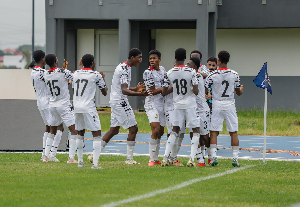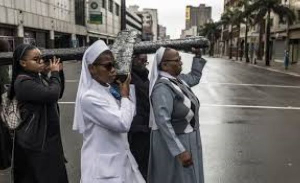A GNA feature by B.A. ADOM
Accra, Aug. 4, GNA - Child labour and child trafficking is now assuming an alarming dimension and cannot be tackled successfully without reference to the root causes coupled with its associated effects. And in Ghana, this phenomenon cannot be denied.
The ILO estimates that, around the world, some 250 million children between the 5-14 age brackets engaged in economic activity for a living. Close to half, about 120 million work full-time everyday all year round. Nearly 70% work in horrendous environment. About 50million to 60 million are between ages 5years and 11 years.
Many of these children come from the rural areas to the urban centres to look for non-existing jobs and if they are lucky to find one, they are paid a pittance.
Child labour may simply be defined as any form of hazardous or light work that is detrimental to the physical, mental, psychological and emotional wellbeing of the child (ILO/IPEC NO. 182).
In Ghana, worst forms of child labour may be put into any of the following categories:
* Sexual exploitation, that is, commercial sex workers or internet pornography
* streetism, for example, truck pushers, dog chain sellers, etc
* involving children working in cocoa farms, fishing, mining and stone quarrying, etc.
* domestic servitude in the cities, especially with middle and upper classes of society
* child trafficking to be used as chop bar attendants and commercial sex workers
* serving under bondage due to the sins committed by their fore fathers or debts owed
The 1992 Constitution also defines a child in article 28(5) as somebody below the age of 18 years old; the same article further states that 93Every child has the right to be protected from engaging in work that constitute a threat to his health, education and development. Indeed, the health implications of children engaged in economic activities could not be told without reference to the national constitution as well as international conventions which recognize the rights of the child and underscores vividly the need for children to enjoy healthy lifestyles.
However, not much has been done by parents to arrest this menace and it still continues to be a problem and a source of worry to many parents due to poverty and ignorance, among other things.
According to UNESCO paper July-Sept, 2004 children rights are being relegated to the background due to age-old traditions that militate against children's progress. In this regard, children are not making headway because they are criminally made to be responsible at an early age when they are supposed to be in school.
In spite of the claims that poverty is the number one cause of children engage in labour, it is also true that many of these children have lost their parents and they have nobody to look up to for social and economic survival due to the breakdown of the extended family system, which hitherto served as a unit for social cohesion and solidarity.
As a matter of fact, this phenomenon has led to the growth of urban slums and shantytowns mostly in the golden triangle namely Accra, Kumasi and Takoradi. Indeed, it is an eyesore to find these children sleeping in kiosks and along pavements and defecating indiscriminately into drains to increase the sanitation problem in and around the Metropolis.
It is no wonder, therefore, to find some of these children growing into adult criminals, 419 gangsters including pressure groups that engage in vandalism to impede national progress.
However, with the recognition of this problem as an issue of national concern and the need to combat it so as to restore hope and aspirations of these selfless children and the youth, there has been a number of interventions within various districts by some organisations in the country, which are all bearing fruits, says Ms Stella Owusu, the Head of the Child labour Unit of the Labour Department.
Some of these organizations including UNICEF, governmental agencies and few local based nongovernmental organisations (NGOs) are working seriously to arrest the menace through programmes of activites and project initiatives.
An important project in this effort is the joint Government ILO/IPEC assisted project dubbed West and Agricultural Project (WACAP) which is being undertaking in a number of communities within Suhum and Kraboa Coaltar Districts in the Eastern Region; Amansie West and Atwima Mponua District, in the Ashanti Region; Sehwi Wiaso District, in the Western Region; as well as the Kassena Nankana District in the Upper East Region.
This project aims at withdrawing children engaged in worst forms of child labour for rehabilitation and reintegration into the society. Another success story in the fight against children engaged in worst forms of labour is the Capitation Grant Scheme, which has now been introduced, which was introduced in September 2005 to cover fees and levies including culture and sports dues and development levies for both pupils of primary and junior secondary schools.
It is expected that this package would inspire parents to enrol their children of school going age into basic schools for a better future.
So far it appears the war against child labour still rages on but reference from the child labour unit indicates that the International Organization on Migration (IOM), which is also championing the cause of children trafficked for labour in Ghana, has chalked a lot of successes in their area of operation. It is collaborating with relevant agencies to implement a project dubbed the 91Yeji Trafficking Project' with focus on withdrawing, rehabilitating and reintegrating of child trafficking victims in the Yeji fishing community with their families.
RECCOMMENDATIONS/ SUGGESTIONS
Child labour must be discouraged in our society since it impacted negatively on national growth and development. It is, therefore, this Writer's view that there should be frequent community visits to identify the root causes of the problem in order to design appropriate training to suit their needs.
It would also be beneficial if materials on the demerits of child labour are made and shared to both teachers and parents within the various communities, which would focus on the problems that these children faced when they came to the urban centres so that they would in turn discuss them with the children during durbars and other social festivities.
In the view of this Writer, there could even be a film show in the form of documentary at the grassroots level on the dangers involved in rural - urban migration in order to make the children to shun any form of bait to lure them to the metropolis.
The ILO convention also postulates the need for individuals, communities, NGOs, human right groups, workers and employers organizations as well as religious bodies to co-ordinate their efforts to stem the tide.
Opinions of Friday, 4 August 2006
Columnist: GNA














